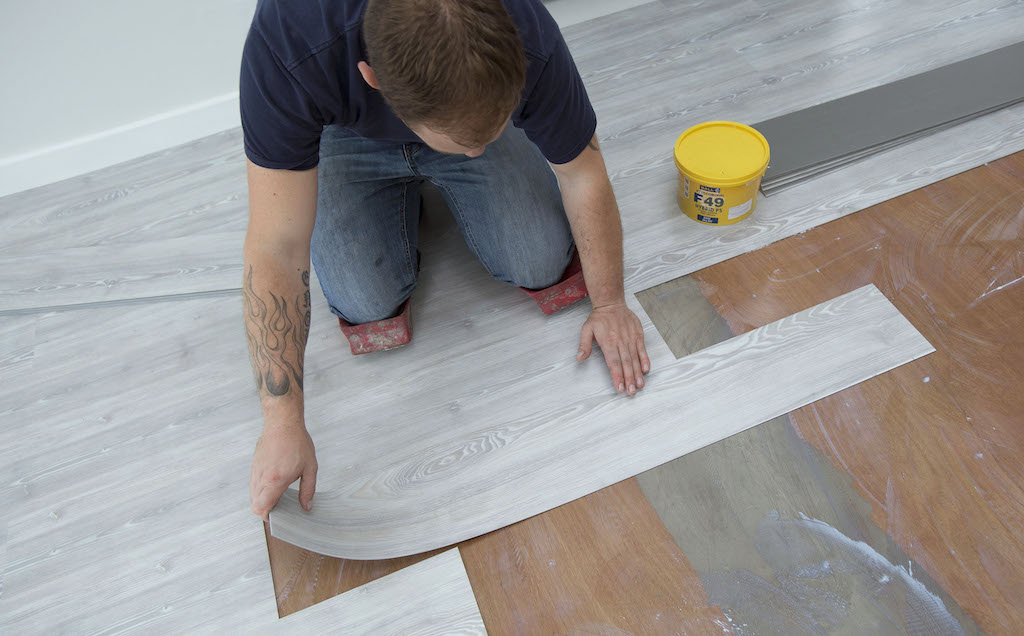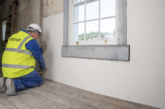Neil Sanders, Technical Director at UK manufacturer of subfloor preparation products and floorcoverings adhesives, F. Ball and Co. Ltd., discusses the variables to consider when determining how to ensure long-lasting resilient flooring installations in damp and humid environments, including new alternatives to traditional solutions.
Flooring in kitchens, bathrooms and wetrooms is exposed to varying degrees of moisture. This necessitates special consideration when installing floorcoverings in these settings to ensure that installations remain in good condition in between refurbishments.
Water that is allowed to get beneath resilient floorcoverings, such as vinyl sheet and tiles, can attack adhesives, causing floorcoverings to blister and de-bond and damage subfloors that are sensitive to moisture, leading to costly floor failures and recalls. Key to preventing this is the use of suitably moisture resistant adhesives and floorcoverings (which depends on how much water they will be exposed to), as well as proper subfloor preparation.
Subfloor preparation
As with any floorcovering installation, appropriate subfloor preparation is imperative to ensuring a long-lasting, professional flooring finish and avoiding floor failure. Before proceeding with any floorcovering installation, it’s important to make sure that the subfloor is suitably sound, smooth and free of any surface contaminants, including old adhesive residues.
In accordance with British Standards, F. Ball recommends the use of a pre-calibrated digital hygrometer to measure the relative humidity (RH) levels within the subfloor as part of any floorcovering installation. If subfloor relative humidity levels exceed 75% RH, a moisture management solution, such as a liquid waterproof surface membrane, will be required to prevent excess subfloor moisture attacking adhesives and damaging floorcoverings.
Floorcoverings
Resilient floorcoverings are an obvious choice for damp and humid environments because they are not affected by moisture like other types of floorcoverings, such as wood, and can easily be cleaned.
Vinyl planks or tiles may be installed in humid environments, such as domestic bathrooms. However, the installation of vinyl sheet is recommended in wetrooms and other areas where floors will be subject to high levels of moisture, including standing water. In these situations, seams must be welded to ensure a watertight seal and prevent an ingression of water. For the same reason, there should be seals where floorcoverings meet drains or capping and coving at walls.
In all cases, floorcoverings and vertical flooring accessories in bathrooms, wetrooms and other environments with high levels of moisture should be installed using a suitably moisture resistant adhesive.

Adhesive selection
Epoxy or polyurethane adhesives have traditionally been the recommended option for making flooring installations resistant to water, inside and outdoors, because of their high resistance to water, oil and grease. The latest advancements in adhesives technology have enabled the creation of one-part, moisture-curing adhesives for internal and external heavy-duty applications, which are also solvent and isocyanate free.
These adhesives have been specially developed to provide the high bond strength required to hold a wide range of floorcoverings in place in the most demanding environments, such as in areas subject to surface water, heavy loads and high foot traffic. They are also easier to apply and faster curing than traditional alternatives, requiring as little as 90 minutes to secure floorcoverings. The fast-setting properties allow welding of sheet floorcoverings to take place from as little as two hours.
Fibre-reinforced formulations are also available which, unlike traditional reactive adhesives, offer high initial grab, limiting lateral movement of floorcoverings while contractors are working, a particular advantage when installing LVTs.
Another solution
The arrival of hybrid adhesives offers another solution for installing resilient floorcoverings in damp and humid environments. As well as being resistant to water, F. Ball’s Styccobond F49 Hybrid PS, for example, offers the familiar characteristics of pressure sensitive adhesives, making it ideal for installing luxury vinyl tiles (LVTs) in these settings. It also develops the extremely high bond strength to hold floorcoverings in place in areas exposed to extreme temperature fluctuations (from -20°C to +60°C), which can cause tenting and gapping at the interface of adjacent tiles and planks and at the edges of floorcoverings.
Excellent resistance to plasticiser migration and high initial grab also makes Styccobond F49 an alternative to contact adhesives for installing vertical flooring accessories, including skirting, capping and coving, which are typically applied to vertical surfaces that may be subject to damp and humid conditions. This means that contractors can now use one adhesive to install both vinyl floorcoverings and accessories in these situations.
Compatibility check
Whatever type of adhesive is required, it’s recommended that contractors check the compatibility with chosen floorcoverings. For these purposes, F. Ball produces its industry-leading recommended adhesives guide (RAG), which lists adhesives recommended for use with over 6,000 floorcoverings, produced by over 200 floorcovering manufacturers. It is available on the F. Ball website and as a free app, as well as a printed booklet
Alternatively, F. Ball’s technical service department is on hand to answer any questions specifiers might have about installing floorcoverings in damp and humid environments or floorcovering-adhesive compatibility. Contractors can also contact floorcovering manufacturers for advice.









